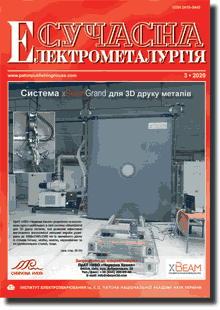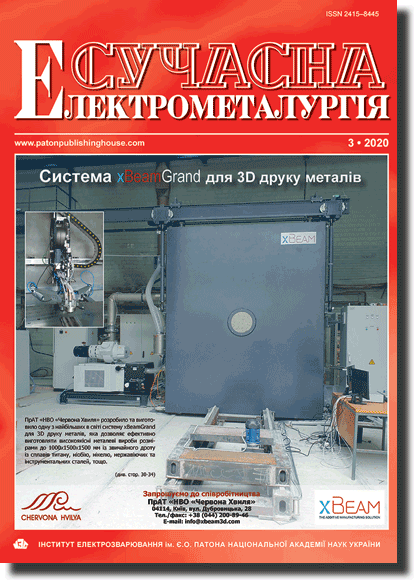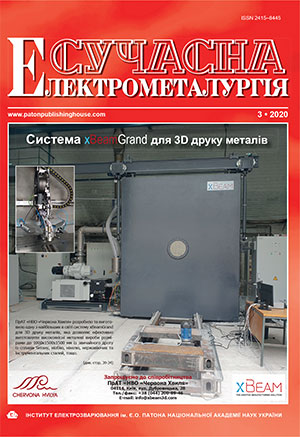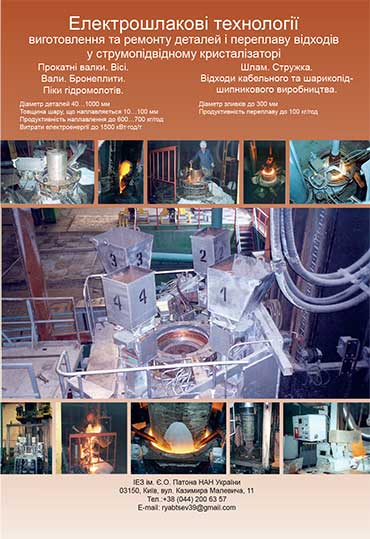| 2020 №03 (07) |
DOI of Article 10.37434/sem2020.03.08 |
2020 №03 (01) |

"Suchasna Elektrometallurgiya" (Electrometallurgy Today), 2020, #3, 54-61 pages
EB PVD synthesis of iron oxide nanoparticles and their biological activity
S.E. Litvin1, Yu.A. Kurapov1, E.M. Vazhnichaya2, Ya.A. Stel’makh1, S.M. Romanenko1, E.I. Oranskaya3
1E.O. Paton Electric Welding Institute of the NAS of Ukraine. 11 Kazymyr Malevych Str., 03150, Kyiv, Ukraine. E-mail: office@paton.kiev.ua
2Ukrainian Medical Stomatological Academy. 23 Shevchenko Str., 36011, Poltava, Ukraine. E-mail: vazhnichaya@ukr.ua
3Chuiko Institute of Surface Chemistry of the National Academy of Science of Ukraine. 17 Naumova Str., 03164, Kyiv, Ukraine. E-mail: oranska@gmail.com The results of studying the structure of porous condensates of Fe–NaCl composition, chemical, phase
Abstract
The results of studying the structure of porous condensates of Fe–NaCl composition, chemical, phase compositions and size of nanoparticles obtained by physical synthesis from the vapor phase using electron-beam physical vapor deposition method, are considered. With a rapid recovery from vacuum, iron nanoparticles are oxidized in the air to magnetite. In the initial state, they have significant sorption capacity with respect to oxygen and moisture. Physically adsorbed oxygen participates in the oxidation of Fe3O4 to Fe2O3. An increase in condensation temperature is accompanied by the increase in size of nanoparticles, as a result of which the total surface area of nanoparticles is significantly reduced, and, consequently, their sorption capacity is decreased. Even without stabilization, such nanoparticles studied as ex tempore prepared aqueous dispersion have characteristic anti-anemic effect in the laboratory animals that can be used in medicine. Ref. 41, Tabl. 2, Fig. 5.
Keywords: EB PVD; iron oxide nanoparticles; sorption; phase composition; colloid systems; anti-anemic effect
Received 01.11.2019
References
1. Willard, M.A., Kurihara, L.K., Carpenter, E.E. et al. (2004) Chemically prepared magnetic nanoparticles. Int. Materials Reviews, 49, 125-170. doi.org/10.1179/095066004225021882. https://doi.org/10.1179/0950660042250218822. Cabuil, V. Magnetic nanoparticles (2008) Dekker encyclopedia of nanoscience and nanotechnology, V. 3, CRC Press, Taylor and Francis Group, Boca Raton, Fl; 1985-2000. https://www.amazon.com/Dekker-Encyclopedia-Nanoscience-Nanotechnology-3/dp/0824750497 https://doi.org/10.1201/NOE0849396397.ch174
3. Revia, R.A., Zhang, M. (2016) Magnetite nanoparticles for cancer diagnosis, treatment, and treatment monitoring: recent advances. Materials Today, 19(3), 157-168. https://doi.org/10.1016/j.mattod.2015.08.022
4. Nikolaev, V.I., Shipilin, A.M., Zakharova, I.N. (2001) On estimating nanoparticle size with the help of the Mössbauer effect. Physics of the Solid State, 43, 1515-1517. https://doi.org/10.1134/1.1395093
5. Thach, C.V., Hai, N.H., Chau, N. (2008) Size controlled magnetite nanoparticles and their drug loading ability. J. of the Korean Phys. Soc., 52, 1332-1335. https://doi.org/10.3938/jkps.52.1332
6. Shpak, A.P., Gorbyk, P.P. (2009) Nanomaterials and supramolecular structures: Physics, chemistry, and applications, Dordrecht, London New York, Springer. http://www.springer.com/gp/book/9789048123087 https://doi.org/10.1007/978-90-481-2309-4
7. Yu, J., Yang, C., Li, J. et al. (2014) Multifunctional Fe5C2 nanoparticles: a targeted theranostic platform for magnetic resonance imaging and photoacoustic tomography-guided photothermal therapy. Advanced Materials, 26(24), 4114- 4120. https://doi.org/10.1002/adma.201305811
8. Ju, Y., Zhang, H., Yu, J. et al. (2017) Monodisperse Au-Fe2C Janus nanoparticles: An attractive multifunctional material for triple-modal imaging-guided tumor photothermal therapy. ACS Nano, 11(9), 9239-9248. https://doi.org/10.1021/acsnano.7b04461
9. Kopanja, L., Kralj, S., Zunic, D. et al. (2016) Core-shell superparamagnetic iron oxide nanoparticle (SPION) clusters: TEM micrograph analysis, particle design and shape analysis. Ceramics Int., 42, 10976-10984. https://doi.org/10.1016/j.ceramint.2016.03.235
10. Tadić, M., Kralj, S., Jagodic, M. et al. (2014) Magnetic properties of novel superparamagnetic iron oxide nanoclusters and their peculiarity under annealing treatment. Applied Surface Sci., 322, 255-264. https://doi.org/10.1016/j.apsusc.2014.09.181
11. Wang, X., Zhang, P., Wang, W. et al. (2016) Magnetic N-enriched Fe3C/graphitic carbon instead of Pt as an electrocatalyst for the oxygen reduction reaction. Chem. Eur. J., 22, 4863-4869. https://doi.org/10.1002/chem.201505138
12. Elmore, W.C. (1938) Ferromagnetic colloid for studying magnetic structures. Phys. Rev., 54, 309-310. https://doi.org/10.1103/PhysRev.54.309
13. Klabunde, K., Sergeev, G.B. (2013) Nanochemistry. Elsevier, 2nd ed. https://www.elsevier.com/books/nanochemistry/klabunde/ 978-0-444-59397-9
14. Cushing, B.L., Kolesnichenko, V.L., O`Connor, C.J. (2004) Recent advances in the liquid-phase syntheses of inorganic nanoparticles. Chem. Rev., 104, 3893-3946. https://doi.org/10.1021/cr030027b
15. Burda, C., Chen, X., Narayanan, R., El-Sayed, M.A. (2005) Chemistry and properties of nanocrystals of different shapes. Ibid., 105(4), 1025-1102. https://doi.org/10.1021/cr030063a
16. Kopanja, L., Milošević, I., Panjan, M. et al. (2016) Sol-gel combustion synthesis, particle shape analysis and magnetic properties of hematite (α-Fe2O3) nanoparticles embedded in an amorphous silica matrix. Applied Surface Sci., 362, 380- 386. https://doi.org/10.1016/j.apsusc.2015.11.238
17. Tadić, M., Kusigerski, V., Marković, D. et al. (2012) Highly crystalline superparamagnetic iron oxide nanoparticles (SPION) in a silica matrix. J. of Alloys and Compounds, 525, 28-33. https://doi.org/10.1016/j.jallcom.2012.02.056
18. Billas, I.M.L., Chatelain, A., de Heer, W.A. (1997) Magnetism of Fe, Co and Ni clusters in molecular beams. J. Magn. Magn. Mater., 168(1-2), 64-84. https://doi.org/10.1016/S0304-8853(96)00694-4
19. Billas, I.M.L., Chatelain, A., de Heer, W.A. (1996) Magnetism in transition-metal clusters from the atom to the bulk. Surface Review and Letters, 3(1), 429-434. https://doi.org/10.1142/S0218625X96000772
20. Gubin, S.P., Koksharov, Yu.A., Khomutov, G.B., Yurkov, G.Yu. (2005) Magnetic nanoparticles: Preparation, structure and properties. Russ. Chem. Rev., 74(6), 489-520. [in Russian]. https://doi.org/10.1070/RC2005v074n06ABEH000897
21. Roca, A.G., Costo, R., Rebolledo, A.F. et al. (2009) Progress in the preparation of magnetic nanoparticles in biomedicine. J. of Physics D: Applied Physics, 42(22), 224002. https://doi.org/10.1088/0022-3727/42/22/224002
22. Movchan, B.A., Kurapov, Yu.A., Didikin, G.G. et al. (2011) Regulation of composition and structure of nanoparticles of Fe-O system in electron beam evaporation of Fe3O4. Poroshk. Metallurgiya, 478(3-4), 56-63. [in Russian]. https://doi.org/10.1007/s11106-011-9314-0
23. Kurapov, Yu.A., Krushinskaya, L.A., Litvin, S.E. et al. (2014) Producing of silver nanoparticles and their thermal stability in Ag-O system. Ibid., 496(3-4), 95-102. doi.org/10.1007/s11106-014-9604-4 [in Russian].
24. Kurapov, Yu.A., Litvin, S.E., Romanenko, S.M. (2013) Structure and thermal stability of Ti-NaCl condensates deposited from the vapour phase in vacuum. Nanostructured Materials Sci., 1, 55-62. http://www.materials.kiev.ua/science/edition_view.jsp?id=2 [in Russian].
25. Kurapov, Yu.A., Litvin, S.E., Didikin, G.G., Romanenko, S.M. (2011) Structure of two-phase condensates Cu-NaCl deposited from vapor phase in vacuum. Sovrem. Elektrometall., 2, 19-22. https://patonpublishinghouse.com/eng/journals/ sem/2011/02/05 [in Russian].
26. Kurapov, Yu.A., Romanenko, S.M., Didikin, G.G., Oranskaya, E.I. (2017) Controllable synthesis of iron oxide nanoparticles in porous NaCl matrix. Materials Research Express, 4(3), 035031. https://doi.org/10.1088/2053-1591/4/3/035031
27. Kovinsky, I.S., Krushinskaya, L.A., Movchan, B.A. (2011) Structure and some properties of sodium chloride condensates produced by electron beam evaporation with next deposition in vacuum. Sovrem. Elektrometall., 1 , 42-46. https://patonpublishinghouse.com/eng/journals/sem/2011/01/08 [in Russian].
28. Chekman, I.S., Ul`berh, Z.R., Malanchuk, V.O. et al. (2012) Nanoscience, nanobiology, nanofarmation. Kyiv, Polihraf plyus. https://www.twirpx.com/file/115774/
29. Laurent, S., Forge, D., Port, M. et al. (2008) Magnetic iron oxide nanoparticles: Synthesis, stabilization, vectorization, physicochemical characterizations, and biological applications. Chem. Rev., 108(6), 2064-2110. https://doi.org/10.1021/cr068445e
30. Santhosh, P.B., Ulrih, N.P. (2013) Multifunctional superparamagnetic iron oxide nanoparticles: Promising tools in cancer theranostics. Cancer Lett., 336(1), 8-17. https://doi.org/10.1016/j.canlet.2013.04.032
31. Jin, R., Lin, B., Li, D., Ai, H. (2014) Superparamagnetic iron oxide nanoparticles for MR imaging and therapy: Design considerations and clinical applications. Curr. Opin. Pharmacol., 18, 18-27. https://doi.org/10.1016/j.coph.2014.08.002
32. Wang, Y.X.J. (2011) Superparamagnetic iron oxide based MRI contrast agents: Current status of clinical application. Quant. Imaging Med. Surg., 1(1), 35-40. doi.org/10.3978%2Fj.issn.2223-4292.2011.08.03
33. Rosner, M.H., Auerbach, M. (2011) Ferumoxytol for the treatment of iron deficiency. Expert Rev. Hematol., 4(4), 399-406. https://doi.org/10.1586/ehm.11.31
34. Roohi, F., Lohrke, J., Ide, A. et al. (2012) Studying the effect of particle size and coating type on the blood kinetics of superparamagnetic iron oxide nanoparticles. Int. J. Nanomedicine, 7, 4447-4458. https://doi.org/10.2147/IJN.S33120
35. Ni, F., Jiang, L., Yang, R. et al. (2012) Effects of PEG length and iron oxide nanoparticles size on reduced protein adsorption and non-specific uptake by macrophage cells. J. Nanosci. Nanotechnol., 12(3), 2094-2100. https://doi.org/10.1166/jnn.2012.5753
36. Briley-Saebo, K.C., Johansson, L.O., Hustvedt, S.O. et al. (2006) Clearance of iron oxide particles in rat liver: effect of hydrated particle size and coating material on liver metabolism. Invest. Radiol., 41(7), 560-571. https://doi.org/10.1097/01.rli.0000221321.90261.09
37. Paton, B.E., Movchan, B.O., Kurapov, Yu.A., Yakovchuk, K.Yu. (2010) Method of producing of metal-oxygen system nanoparticles with specified composition by electron beam evaporation and condensation in vacuum. Ukraine, Pat. 92556. http://base.ukrpatent.org/searchINV/search.php?action=viewdetails&IdClaim=151646 [in Ukrainian].
38. Lebedev, A.D., Levchuk, Y.N., Lomakin, A.V. (1987) Clearance of iron oxide particles in rat liver: Effect of hydrated particle size and coating material on liver metabolism. Ed. by V.A. Noskin. In: Laser correlation spectroscopy in biology. Kiev, Naukova Dumka. https://search.rsl.ru/ru/record/01001388286 [in Russian].
39. Merkus, H.G. (2009) Particle size measurements. Fundamentals, practice, quality, Springer. http://www.springer.com/gp/book/9781402090158
40. Vazhnycha, O.M., Moklyak, E.B., Movchan, B.O., Kurapov, Yu.A. Method of treatment of acute hemorrhage using the nanoparticles of iron oxide. Ukraine, Pat. 103401 http://uapatents.com/6-103401-sposib-likuvannya-gostro-krovovtrati-za-dopomogoyu-nanochastinok-oksidu-zaliza-ii-iii.html [in Ukrainian].
41. Litvin, S.E.,Kurapov, Yu.A., Vazhnichaya, E.M. et al. (2019) Synthesis of iron oxide nanoparticles by method of electron beam deposition in vacuum. In: Proc. of 9th Int. Conf. on Beam Technologies in Welding and Materials Processing. Ed. by I.V. Krivtsun. IAW, 63-70. https://patonpublishinghouse.com/proceedings/ltwmp2019.pdf
Advertising in this issue:
The cost of subscription/purchase order journals or individual articles
| Journal/Currency | Annual Set | 1 issue printed |
1 issue |
one article |
| TPWJ/USD | 384 $ | 32 $ | 26 $ | 13 $ |
| TPWJ/EUR | 348 € | 29 € | 24 € | 12 € |
| TPWJ/UAH | 7200 UAH | 600 UAH | 600 UAH | 280 UAH |
| AS/UAH | 1800 UAH | 300 UAH | 300 UAH | 150 UAH |
| AS/USD | 192 $ | 32 $ | 26 $ | 13 $ |
| AS/EUR | 180 € | 30 € | 25 € | 12 € |
| SEM/UAH | 1200 UAH | 300 UAH | 300 UAH | 150 UAH |
| SEM/USD | 128 $ | 32 $ | 26 $ | 13 $ |
| SEM/EUR | 120 € | 30 € | 25 € | 12 € |
| TDNK/UAH | 1200 UAH | 300 UAH | 300 UAH | 150 UAH |
| TDNK/USD | 128 $ | 32 $ | 26 $ | 13 $ |
| TDNK/EUR | 120 € | 30 € | 25 € | 15 € |
AS = «Automatic Welding» - 6 issues per year;
TPWJ = «PATON WELDING JOURNAL» - 12 issues per year;
SEM = «Electrometallurgy Today» - 4 issues per year;
TDNK = «Technical Diagnostics and Non-Destructive Testing» - 4 issues per year.








